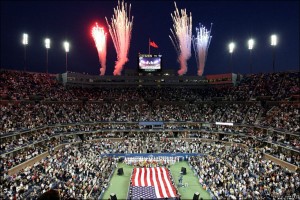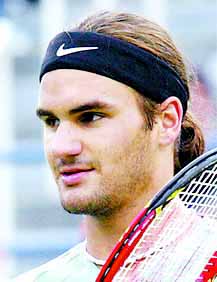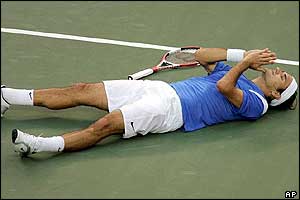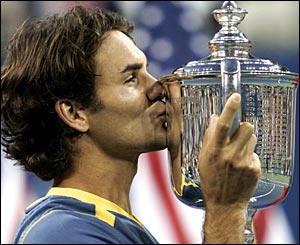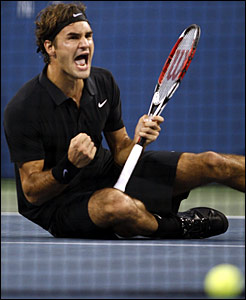A Decade’s Worth of U.S. Open Appearances for Roger Federer
Is there anything more exhilarating in all of tennis then the famous night sessions on Arthur Ashe Stadium? This is when all the stars shine in the stands as well as on the court. Celebrities pack Arthur Ashe to see the best the tennis world has to offer and generally they are not disappointed.
The last slam of the season sizzles in dying shades of summer as the northern hemisphere begins to edge toward desultory fall and sobering winter. The extreme heat often reappears during the two weeks of the U.S. Open that may stretch over the Labor Day weekend.
Roger Federer continues to be one of the staples of the U.S. Open, having reached the finals there for the past six years. Will he make it for a seventh? That seems to be the question on everyone’s lips these days.
Let’s look back on a decade’s worth of Federer matches.
Roger Federer at the U.S. Open – the Early Years [2000-2003]
The year was 2000 and Roger Federer had made it into the field at the U.S. Open for the first time where he was, naturally enough, unseeded. The previous year the Swiss had failed to qualify.
In 2000, Federer advanced to the third round where he met Spaniard Juan Carlos Ferrero, seeded No. 12. Federer lost that contest 5-7, 6-7, 6-1, 6-7. He did not go down without a fight, but in the end the rising star did suffer defeat. In the process he got a taste of the Big Apple and decided this place was special.
In 2001, Federer made it to the fourth round. Unfortunately for the Swiss, there he faced American Andre Agassi and came up short––very short to the No. 2 seed. Agassi won 1-6, 2-6, 4-6. Federer would have an opportunity to redeem himself for his poor play during this match with the renowned American.
Early on the fourth round became Federer’s greatest hurdle. He lost to his former doubles partner Max Mirnyi, seeded No. 32 at the 2002 U.S. Open. Federer was seeded No. 13 but still lost in straight sets to Mirnyi 3-6, 6-7, 4-6.
Federer did not lose in straight sets in 2003. But he did lose to Argentine David Nalbandian again in the fourth round, 6-3, 6-7, 4-6, 3-6. This year the Swiss was the No. 2 seed while Nalbandian came in as the No. 13 seed.
Who said 13 was an unlucky number?
Nalbandian would prove to be the last man to defeat Federer at the U.S. Open until countryman Juan Martin del Potro accomplished the feat in 2009.
If you wish to see some of the action from the 2003 match click here.
2004: Roger Federer Wins His First U.S. Open – 6-0, 7-6, 6-0
It wasn’t really a tennis match at all. It was something verging on perfection as Roger Federer overcame a man who never quits––Lleyton Hewitt to win his first U.S. Open Championship 6-0, 7-6, 6-0.
Federer dominated the first and last sets––sandwiched in between was Hewitt’s attempt at redemption, his attempt to come back against a man playing almost flawless tennis. While Hewitt gave it his best, in the end, he had no answers.
With that win, Federer became the only man in the history of the sport to win his first four grand slam finals and the first man since Mats Wilander to win three majors in one calendar year.
Hewitt came into the final at full strength having won his last 16 matches, advancing into the men’s final without dropping a set. Everyone expected a tight match.
The first set, however, was over in 18 minutes with Federer’s forehand dominating the action. Hewitt reeled under the assault. The second set started with a break of Hewitt’s serve and many feared a rout. But, the Aussie never gave up and he fought back hard, finally breaking back at 5-5, trying to deny Federer the second set.
Federer reestablished control early in the tie break and swept away any hope Hewitt had to win the second set. By the time the third set come into focus, Hewitt was toast, having spent all his energies in the second.
Federer took the third at love. Hewitt stood racket in hand with two bagel sets against him. Hewitt himself admitted that what Federer had accomplished by winning his third slam title of the year was incredible, especially when considering the depth of talent in men’s tennis in 2004.
If you wish to sample a flavor of this match click here.
Roger Federer Wins His Second U.S. Open in 2005
The opponent in 2005 was America’s own Andre Agassi. Federer won the first set 6-3. Agassi, perhaps fearing a straight set loss, came back strong to take the second 6-2.
It was even going into the third set where Federer found himself immediately under pressure as Agassi broke him––to go up 4-2. The pro-American New York crowd went crazy but Federer refused to fold and broke back immediately.
Agassi poured every ounce of power and determination into the third set, but Federer held his nerve and the two decided to settle matters in a tiebreak.
The Swiss, however, took the tiebreak without looking back, allowing Agassi only a single point. Then Federer swept to the finish line, winning the match 6-3, 2-6, 7-6, 6-1.
During his press conference Federer acknowledge the importance of the match––defeating Agassi in New York was a dream come true.
At age 35, Agassi was the oldest finalist since 1974 when Ken Rosewall played at age 39. 2005 marked Agassi’s last final at Flushing Meadows with retirement to follow shortly. It remains a memorable final with two great champions.
To watch some of the action from this great match, click here.
Roger Federer Scores His Third U.S. Open Victory in 2006
By winning the U.S. Open in 2006, Roger Federer became the first man to win three Wimbledon titles and three U.S. titles consecutively in the same years. It was just one of many records the phenomenal Swiss was accumulating.
Federer winning three U.S. Opens consecutively equaled Ivan Lendl who was the last man to accomplish this feat in 1987.
His opponent in 2006 was American, Andy Roddick who won this title in 2003. Once again it was the critical third set that sealed the fate for both players, after they had each won a set.
Roddick’s fortunes improved when he hired Jimmy Connors to become his coach earlier that year. Getting to the finals of the U.S. Open marked the American’s return to the top of the men’s game––a huge step forward for Roddick.
After Federer took the first set, Roddick broke Federer immediately then used his lethal serve to hang on and take the second set.
In the third both players seemed to notch their games up into another gear. With break points on Federer’s serve in the fifth game, Roddick could not convert. Roddick then saved five break chances on his own serve. The set grew increasingly tense.
Finally, the defending champion found one more gear and broke Roddick in game 12 to take the set. After that, the match was a mere formality as Roddick quickly folded in the fourth set.
To see exactly how it transpired watch highlights of this match by clicking here.
Roger Federer Secures His Fourth U.S. Open Title in 2007
It was the “black” year. The media began designating the Swiss as “Darth Federer,” as the Swiss donned an all black ensemble for the night sessions and his championship match.
Perhaps it was a signal of foreboding because the final took on a dark tone for the man who seemed to flourish in Flushing Meadows.
Yes, Roger Federer won his fourth consecutive U.S. Open in straight sets against new-comer Novak Djokovic age 20––but he seemed in trouble the whole match.
Trailing by a break in each set, waiting for the final blow to descend, the Serbian youngster, instead, caved in critical moments and let the master dominate.
That is not to say that Federer did not play well but he appeared nervous and uncertain at times and these doubts had not surfaced in the Federer psyche for a long time, especially in not in New York where the Swiss usually felt supremely confident, playing loose and free.
In the first set, playing somewhat tentatively, Federer lost his serve in the 11th game. Djokovic served for the first set and was up 40-0 when the wheels came off his game. It is easy to say the Serb choked but perhaps that is an exaggeration. He did manage to lose the next five points and eventually the game, allowing Federer to even the set.
In the tiebreak, Federer scrambled from behind to even matters securing the set when Djokovic double faulted to give the Swiss the first set.
As Federer’s forehand seemed to take on an aberrant life of its own, Djokovic came back, breaking Federer’s serve in the first game of the second set. But the Serb could not contain his advantage and ceded the game back as Federer broke Djokovic’s serve in game seven.
Once again, the set ended in a tiebreak after several more tense moments on the Federer serve. But this tiebreak had a different feeling as a confident Federer finally emerged, taking command of the tiebreak and the set three.
It finally became evident that Djokovic wasn’t going to take advantage of his superior play and the moment was too great for the Serb. Federer closed out the match in three sets, 7-6, 7-6, 6-4.
The Swiss became the first man to win the U.S. Open and Wimbledon four years in a row. He also earned another record in winning four consecutive U.S. Open championships––the first man to do so since Bill Tilden in the 1920s.
To watch some thrilling action from this match click here.
Roger Federer Seals His Fifth U.S. Open Victory in 2008
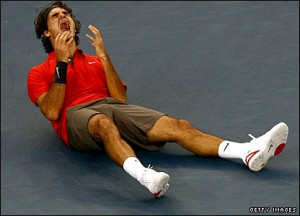
Federer wins his fifth consecutive title at the U.S. Open in 2008, defeating first-time finalist Andy Murray.
The man with the soft hands and the nimble feet recorded his fifth consecutive U.S. Open Championship at the expense of Andy Murray who had reached his first slam final by dismissing the No. 1 seed, Rafael Nadal.
But, 2008 had not been a typical glorious year for the former No. 1 as Federer fell in the finals at the French Open in straight sets to Rafael Nadal in embarrassing fashion.
Then the Swiss Maestro saw his beloved Wimbledon crown slip away––also at the hands of the surging Majorcan who replaced him as the No. 1 player in the world. To add insult to injury Nadal swept the table taking the Olympic Gold Medal as well.
The win at the U.S. Open in 2008 stopped the bleeding, applying a tourniquet to the Federer psyche. It also gave Federer his 13th grand slam singles title, pushing him past Roy Emerson and leaving him only one behind American great Pete Sampras.
Murray found himself down in set one as he sent the deciding ball into the net during the sixth game allowing Federer to break going up 4-2. In less than half an hour Murray was down one set to Federer.
In the second set, the two traded breaks early. Federer’s final break of the Murray serve gave him set two. In the third set, the Scot settled into defeat and let Federer pretty much have his way, 6-2, 7-5, 6-2.
Murray did not rise to the grand occasion and seemed tentative at best on court, playing into Federer’s hands and becoming Federer’s fifth straight victim in the championship match.
To see how Federer managed this win click here.
Roger Federer Loses the U.S. Open in 2009
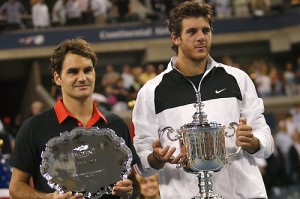
Juan Martin del Potro wins his first U.S. Open title in 2009, defeating five-time winner Roger Federer in a hard fought contest.
Nothing lasts forever, not even for Roger Federer who seemed to own the U.S. Open Championship. Juan Marin del Potro had to fight for his life in this match but he never relinquished his belief that he could defeat the man across the net, the world No. 1 Federer.
Federer had not lost a match in New York for five years. He was in the final for the sixth consecutive year and hoping for a sixth consecutive win to tie him with Bill Tilden who accomplished it in the 1920s.
Del Potro, age 20, managed to accomplish what his peers, Andy Murray and Novak Djokovic were unable to accomplish at Arthur Ashe stadium, outlast and overcome Federer in a final.
Besides Rafael Nadal, del Potro became only the second man in history to defeat Federer in a slam final.
Del Potro joined Guillermo Vilas as the second Argentine to win the U.S. Open title. Fittingly, Vilas was on hand to watch his compatriot win the title.
Going into the match, Federer owned the young Argentine having won their first six contests. But del Potro seemed to learn from each of his losses and his confidence grew with each match.
Several times during the match, Federer held set points and match points, but like the Federer of old, del Potro fought his way back––this time casting Federer in the role of the vanquished.
In the semifinals del Potro had demolished Nadal 6-2, 6-2, 6-2––sending notice to everyone that a new star was rising.
The final was an amazing match to witness as it see-sawed back and forth. Each player seemed to be shutting the other down. But the last and greatest ascendency came in the fifth set when del Potro closed the door quickly denying Federer another opportunity to find a way to win.
All human beings in motion must come to rest as some point in time. Federer’s reign as the U.S. Open Champion was stilled for the moment. But perhaps, he will find a way to win there again – if nothing else – simply out of habit.
Watch highlights of the end of this thrilling match by clicking here.
